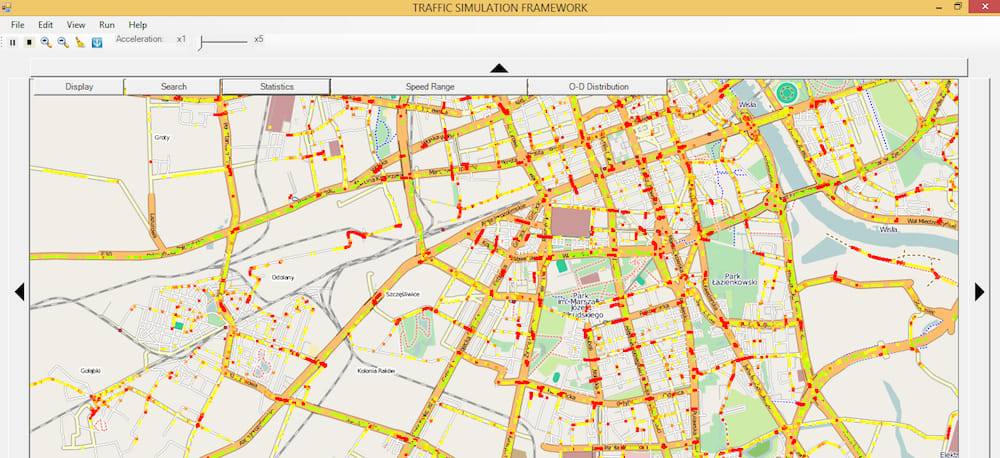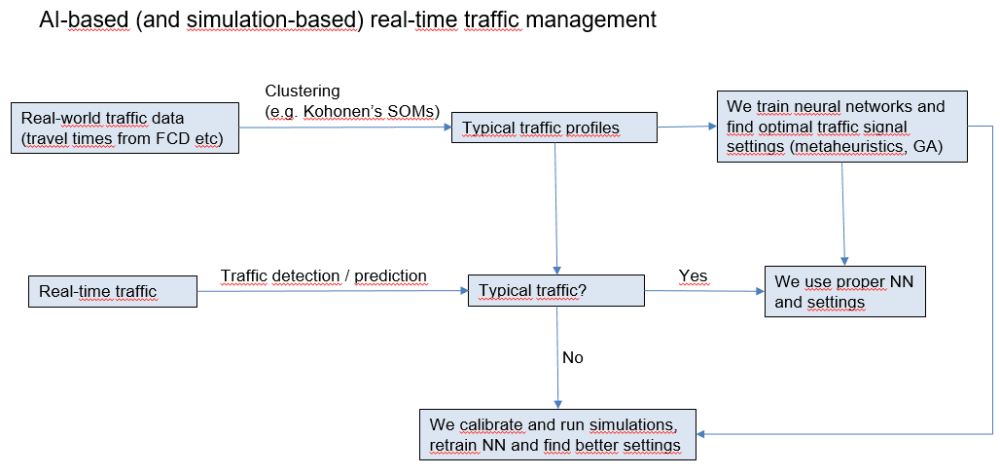Vehicular traffic in cities has a significant impact on environment, economy and life of many people. Thus, it is important to manage and organize it optimally and AI and new technologies may bring significant progress in this field. However, many traffic and transport optimization issues are NP-hard and are difficult to be solved optimally, especially in a large scale.
I am developing software for a large-scale traffic simulation, Traffic Simulation Framework (TSF), which can be used to design optimal traffic control strategies and optimal transport infrastructure, using advanced AI methods. In particular, I am applying neural networks to approximate outcomes of traffic simulations in order to speed up required computations, to evaluate large number of settings (e.g., traffic signal control strategies, locations of parkings or charging stations for electric vehicles) and choose best, according to defined rules, using metaheuristics (e.g., genetic algorithm). The method may be especially successful in the era of connected and autonomous vehicles, which are expected to transform the whole transportation area in the near future. For such cars, it may be much easier to predict traffic in different conditions, thanks to knowledge about algorithms of drive, which can be simulated (e.g., in TSF). Similar approaches may be useful in case of aerial traffic of drones, once their amount in the air will be so large that virtual air roads would need to be established to ensure safety and efficiency of the air traffic. Drones may be also used as a new source of traffic data, they can fly over roads and monitor real-time traffic conditions, so may replace large number of cameras and inductive loops in use nowadays for traffic detection. Another innovative source of traffic data are floating car data, collected directly from mobile devices or onboard computers installed in cars, with access to GNSS data, which can help in providing accurate trajectory, with a support of other devices and Vehicle-to-vehicle and vehicle-to-infrastructure communication. Vehicle-to-infrastructure communication realized using DSRC (dedicated short-range communication) may help in acquiring data from vehicles.
To ensure security of communication, I consider applying blockchain-based approach. To speed up required computations (e.g., calibrating and running traffic simulations, training and inferring neural networks), I assume taking advantage of Big Data frameworks, such as Apache Spark, and dedicated processing units, e.g., Graphical Processing Units and Tensor Processing Units. To ensure scalability, robustness, reliability and effectiveness, I consider running most of demanding computations in a cloud infrastructure. My solution may found many applications, e.g., in offline transport planning (finding optimal locations and capacities of parkings and charging stations for electric vehicles, planning optimal routes and public transport), planning urban and rural areas (e.g., where to build a bridge, hospital, school, shopping mall – I am building models of mobility in the area close to the Senegal-Guinea border to help in designing new infrastructures for the future planning and development of this region), real-time traffic prediction (for GPS navigation, taxi providers, traveller information systems), real-time traffic management, assessing risk of traffic jams and accidents (for insurance).
Video
Like this entry?
-
About the Entrant
- Name:Pawel Gora
- Type of entry:individual
- Software used for this entry:Traffic Simulation Framework, TensorTraffic
- Patent status:none








